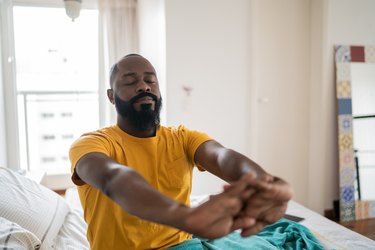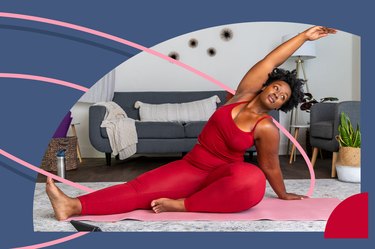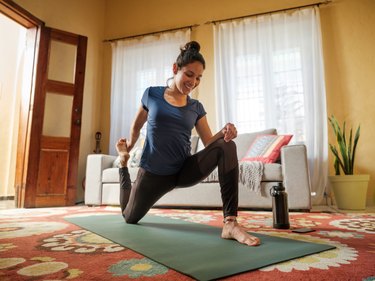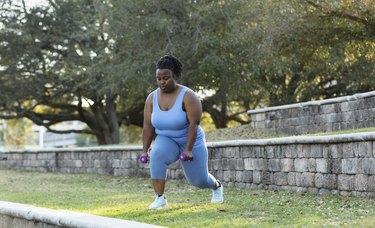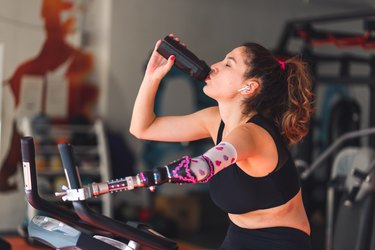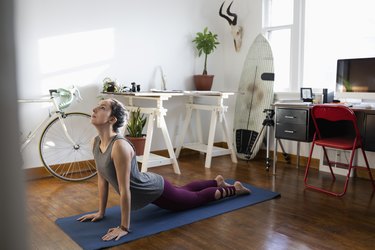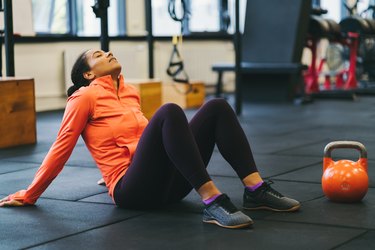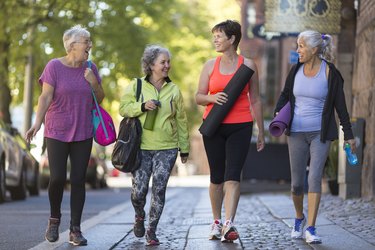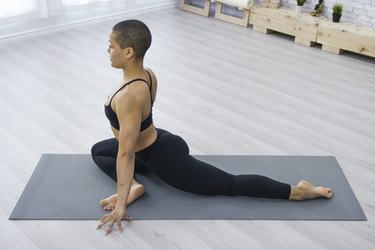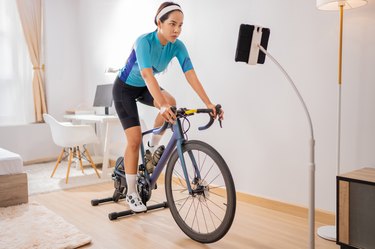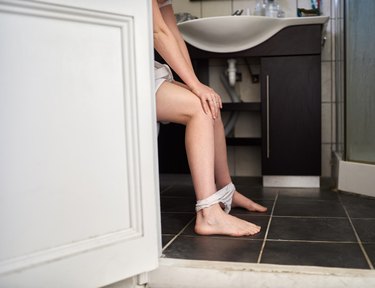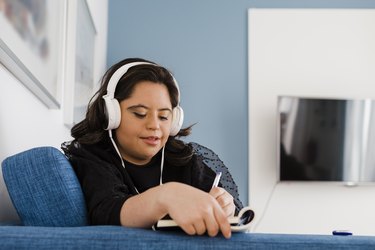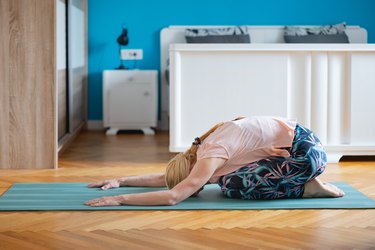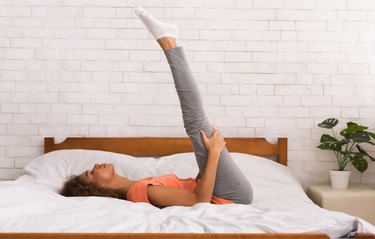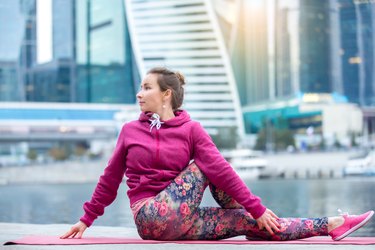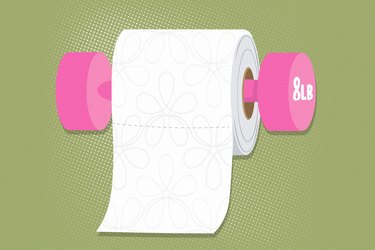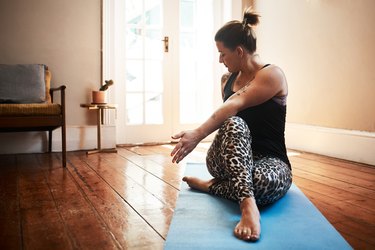
Your body works most efficiently when it has regular movement. In fact, your body lets you know, in both subtle and not-so-subtle ways, that it is craving more exercise.
Most people equate not moving or exercising enough with seeing the numbers creep up on the scale or not feeling as toned — and those are definitely signs. However, things like difficulty sleeping, joint pain and feeling anxious or moody can also be indicators your body needs to move.
Video of the Day
Video of the Day
And even if you exercise for 30 minutes each morning, if you sit the rest of the day you still may not be getting enough movement to keep your body happy. This is why the National Institutes of Health recommends that you set an alarm and stand up and move around for two or three minutes each hour.
Here are the top 10 physical and mental signs that your body is craving more movement.
1. Joint Pain and Stiffness
"Many people don't exercise because they think it will increase joint pain and stiffness. While there may be some transient increase in discomfort in the beginning, there is an overall net positive effect in the long run," says Bradley Dyer, DO, physician and founder of Premier Integrative Health.
"It's actually physical inactivity that leads to chronic joint pain and stiffness by increasing inflammation and reducing joint mobility. Regular physical activity supports joint health by promoting the production of synovial fluid, which lubricates the joints, reducing friction and enhancing mobility."
2. Brain Fog
If you feel like you can't concentrate or are having difficulty solving a problem at work, inactivity may be to blame. "Lack of exercise can lead to reduced blood flow, affecting the brain's ability to function optimally and impacting concentration, memory, and overall cognitive abilities," Dr. Dyer says.
"Physical activity enhances blood flow to the brain, promoting the growth of new neurons and improving neural connectivity. Exercise also turns on several genes that improve cognitive health and is a potent stimulator of BDNF [Brain Derived Neurotrophic Factor] which is like 'miracle grow' for the brain," he says.
3. Low Energy
Feeling sluggish or falling asleep at your desk? Your body is telling you it needs more movement.
"Nobody just 'has' energy, we have to generate energy," Dr Dyer says. "The organelles in our body responsible for generating energy are called mitochondria. The best way to improve mitochondrial function and encourage the body to make more mitochondria is to engage in regular exercise."
"High-intensity interval training (HIIT) is one of the best ways to accomplish this," he says.
4. Muscle Tension or Knots
"Tension in your neck, shoulders, legs or other areas can be a sign that you need to move. This is your body communicating with you," says Jen Aks, embodiment coach and founder of The Power of Gesture.
Moving frequently helps to increase circulation, loosen up your muscles and prevent muscle imbalances from staying in one position too long. "A great way to relax the tension is to move. Walk, dance, or do a simple and achievable practice," she says. "You would be surprised at how much tension can be released by just moving your hands."
5. Stress, Anxiety and Depression
"Exercise is a natural stress reliever. It reduces the production of stress hormones like cortisol and triggers the release of endorphins, which are natural mood boosters," Dr. Dyer says.
If you haven't exercised in awhile, getting some movement in — even just some gentle yoga — can reduce your cortisol levels and boost your mood, according to a small 2013 study in the Indian Journal of Psychiatry.
"Regular physical activity also promotes relaxation, improves sleep quality and increases self-confidence, all of which contribute to reducing stress, anxiety and mood swings," he says, referring to a 2023 systematic review in the British Journal of Sports Medicine which shows that "consistent exercise was 1.5 times (150 percent) better than the leading antidepressant or psychotherapy at improving symptoms of depression and anxiety."
6. Increased Appetite
Don't believe the maxim that exercise will always make you more hungry: A 2018 study in Nutrients found that exercise actually helps curb your appetite.
A more recent 2022 animal study in Nature discovered that high-intensity exercise, such as running, swimming, weightlifting and cycling, turned on an "anti-hunger" molecule that helped curb appetite.
And even if you don't do high-intensity exercise, lower intensity exercise like going for a walk outside can help prevent snacking out of boredom.
7. Feeling Irritable or Fidgety
"Feeling fidgety or irritable can definitely be a sign that your mind is craving an outlet," Aks says. "Movement relaxes the energy and allows for more fluidity. As a result, the energy releases, and the fidgeting is replaced with a sense of calm."
If you're angry, a short bout of moderate-intensity exercise might help, according to a small July 2019 study published in Medicine & Science in Sports & Exercise. After 30 minutes of moderate-intensity cycling, 16 college students had lowered levels of anger.
While more research needs to be done specifically on exercise's effect on anger, irritability is often a symptom of depression and anxiety. And as we mentioned, science and experts agree that exercise is an important method of improving mental health.
8. You Keep Getting Sick
Do you feel like you keep getting sick or can't get over that lingering cough? Your body may be telling you it's time to move more.
A 2019 review in the Journal of Sport and Health Science found that moderate exercise has an anti-inflammatory response and that regular exercise improves your immune system and decreases your illness risk.
Make sure you're not overdoing it, though: The study found that over-exercising can lower your immune response.
9. You Can’t Sleep
If you are having trouble getting to sleep and staying asleep, John Hopkins Medicine says that not getting enough movement may be to blame. They report that 30 minutes of moderate aerobic exercise helps you fall asleep faster and improves the quality of your sleep.
On the other hand, not getting enough exercise not only affects your sleep but also leads to lower levels of activity the next day, which can turn into a vicious cycle.
As far as when to exercise, they recommend exercising whenever it works out best for your schedule — however, avoid vigorous exercise an hour before bedtime.
10. You're Constipated
Feeling a bit backed up? If so, it's time to get moving. A 2019 review and meta-analysis in the Scandinavian Journal of Gastroenterology found that those who did 140 min or more of aerobic exercise per week (around 30 min per day, five days a week) improved their constipation symptoms.
Even more research backs up the idea that people who move regularly have more regular bowel movements: A June 2022 meta-analysis in Contemporary OB/GYN found that moderate and high levels of activity were associated with a lower risk of constipation and that getting more physical activity can help manage chronic constipation.
The bottom line: Movement stimulates your intestines to also get moving!
How to Move More Each Day
"If you find yourself craving movement or exercise, make sure you listen," Aks says. "Too many times we ignore the signals that the body gives us."
Make sure you follow the Physical Activity Guidelines for Americans guidelines of at least 150 minutes per week of moderate-intensity physical activity (30 minutes a day, 5 days a week) and two days of muscle-strengthening activity.
In addition, if you are sitting throughout the day, stand up at least once an hour and walk around or do some quick stretches or dancing for two to three minutes.
Find other opportunities to sit less and get more movement in your day, through parking farther away, taking the dog for a walk or walking instead of driving to lunch. You can also consider a stand-up or treadmill desk so you can walk while you work.
"There are many ways to move, it's about finding the one that works best for you," Aks says.
- National Institutes of Health: "Don’t Just Sit There! Move for Your Health"
- British Journal of Sports Medicine: "Effectiveness of Physical Activity Interventions for Improving Depression, Anxiety and Distress: An Overview of Systematic Reviews"
- Nutrients: "Acute and Chronic Effects of Exercise on Appetite, Energy Intake, and Appetite-Related Hormones: The Modulating Effect of Adiposity, Sex, and Habitual Physical Activity"
- Journal of Sport and Health Science: "The Compelling Link Between Physical Activity and the Body's Defense System"
- Scandinavian Journal of Gastroenterology: "Exercise Therapy in Patients With Constipation: A Systematic Review and Meta-Analysis of Randomized Controlled Trials"
- Physical Activity Guidelines for Americans: "How Much Physical Activity Do Adults Need?"
- John Hopkins Medicine: "Exercising for Better Sleep"
